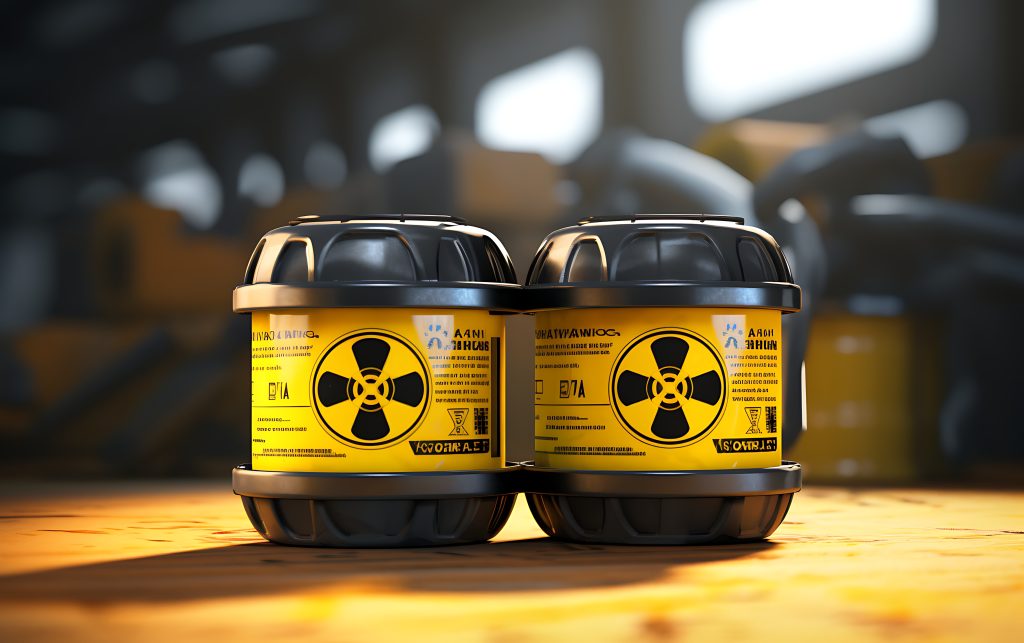Do you ever wonder how a nuclear reactor works and what its purpose is? In this article, we’ll take you on a journey to explore the definition and meaning of a nuclear reactor. You’ll discover its main components, like the core, coolant, turbine, cooling tower, and containment structure. We’ll also delve into different types of reactors, such as pressurized water reactors and boiling water reactors. By the end, you’ll have a comprehensive understanding of how nuclear reactors generate electricity and power industries. Let’s unlock the mysteries together.
Nuclear Reactors and Nuclear Fission
Nuclear reactors harness the power of nuclear fission to generate electricity. This process involves the splitting of heavy atoms, releasing a significant amount of energy. The use of nuclear reactors presents both pros and cons. On the positive side, they provide a reliable source of electricity without greenhouse gas emissions, contributing to energy independence and reducing reliance on fossil fuels. Moreover, nuclear power plants have a long operational lifespan and the fuel used in reactors is relatively inexpensive and abundant. However, there are also safety concerns and environmental impacts associated with nuclear reactors. Safety measures and regulations are in place to prevent accidents, and reactor operators undergo extensive training to ensure safe operation. Additionally, regulatory bodies oversee the safety of nuclear reactors. As for environmental impact, nuclear power plants release radioactive gases and liquids under controlled conditions to minimize their effects. Future developments in nuclear reactors aim to improve safety, increase efficiency, and reduce waste generation. Economic viability is a key factor in the expansion of nuclear power, as initial capital costs, fuel, and maintenance can be significant. Overall, nuclear reactors offer a promising solution for electricity generation but require careful consideration of safety, environmental, and economic factors.
Main Components of a Nuclear Reactor
Now let’s delve into the main components of a nuclear reactor and how they contribute to the generation of electricity.
- Nuclear Reactor Fuel: The core of a nuclear reactor contains the fuel, typically uranium, which undergoes nuclear fission to release heat energy. The fuel is processed into small ceramic pellets and stacked into fuel rods, which are then bundled together to form a fuel assembly. The fuel pins within the assembly undergo fission, releasing energy in the form of heat.
- Reactor Coolant: The coolant circulates through the core, absorbing heat from the fuel. Water is commonly used as a coolant in light-water reactors. It helps regulate the temperature of the core and transfers the heat to a turbine. The coolant is crucial for the efficient operation of the reactor.
- Reactor Core Design: The reactor core is where the fuel is housed and the fission reactions occur. The design of the core is carefully engineered to optimize the fission process and ensure the efficient production of heat energy.
- Reactor Safety Features: Nuclear reactors incorporate multiple safety features to prevent accidents and mitigate risks. These may include control rods for regulating the reaction rate, emergency shutdown systems, and containment structures to isolate the reactor from the environment in case of a malfunction.
- Reactor Control Systems: To maintain safe and stable operation, reactors have control systems that monitor and adjust various parameters, such as neutron flux and coolant flow. These systems are crucial for maintaining the desired power output and preventing any deviations from safe operating conditions.
Types of Nuclear Reactors
Let’s now discuss the different types of nuclear reactors. The main types include pressurized water reactors (PWR), boiling water reactors (BWR), advanced gas-cooled reactors (AGR), light water graphite-moderated reactors (LWGR), and fast neutron reactors (FNR). Each of these reactor designs has its own characteristics, advantages, and limitations, and they are used in various applications around the world.
Pressurised water reactor (PWR)
A pressurized water reactor (PWR) is a type of nuclear reactor that uses highly pressurized water as both a coolant and a moderator. It operates through the nuclear fission process, where the nucleus of a heavy atom splits into lighter nuclei, releasing energy. In a PWR, the core heat generation occurs when the fuel undergoes fission reactions. The reactor cooling systems in a PWR utilize highly pressurized water to transfer heat from the core to the turbines. To control the reaction rate, reactor control mechanisms such as control rods can be inserted or withdrawn. The use of pressurized water as both a coolant and moderator allows for efficient heat transfer and safe operation of the PWR.
Boiling water reactor (BWR)
The boiling water reactor (BWR) is another type of nuclear reactor that continues the discussion from the previous subtopic by utilizing a different cooling system. In a BWR, water is used as both the coolant and the moderator, similar to a pressurized water reactor (PWR). However, unlike a PWR, a BWR allows the water to boil directly in the reactor core. This boiling water produces steam, which is then used to spin a turbine and generate electricity. The BWR design features several safety measures, such as emergency core cooling systems and containment structures, to ensure the safe operation of the reactor. The fuel assembly in a BWR consists of fuel rods, which contain ceramic pellets of uranium. The operating principles of a BWR involve the control of reactor power through the insertion or withdrawal of control rods and the continuous circulation of coolant to remove heat generated by nuclear fission.
Advanced gas-cooled reactor (AGR)
An AGR is a type of nuclear reactor that utilizes advanced gas cooling technology. It is designed with specific features that enhance safety, efficiency, and waste management in nuclear reactor operations. Here are some key aspects of AGRs:
- Advanced gas cooling: AGRs use carbon dioxide gas as a coolant, which offers better heat transfer capabilities compared to water-based systems.
- Nuclear reactor design: AGRs have a unique fuel design, with uranium dioxide pellets enclosed in stainless steel tubes, ensuring better fuel integrity and performance.
- Nuclear reactor safety: AGRs have multiple safety systems, including emergency shutdown mechanisms and passive cooling systems, to prevent accidents and mitigate potential risks.
- Nuclear reactor efficiency: AGRs are known for their high thermal efficiency, allowing for effective utilization of the heat generated during the fission process.
- Nuclear reactor waste management: AGRs produce lower volumes of radioactive waste compared to other reactor types. The waste is carefully managed and stored to ensure long-term safety and minimal environmental impact.
Light water graphite-moderated reactor (LWGR)
To understand the Light water graphite-moderated reactor (LWGR) in more detail, let’s delve into its unique characteristics and operating principles. The LWGR is a type of nuclear reactor that utilizes light water as both a coolant and a moderator, while graphite is used as a moderator to slow down the neutrons. This design enables efficient fission reactions and ensures nuclear reactor safety. The LWGR has a fuel cycle that involves the use of uranium as nuclear fuel, which is processed into ceramic pellets and stacked into fuel rods. After the fuel is burned, the LWGR produces waste that needs to be properly disposed of. Furthermore, at the end of its operational lifespan, the LWGR requires decommissioning procedures to be carried out to ensure the safe dismantling of the reactor. Overall, the LWGR is known for its efficiency, safety measures, waste disposal protocols, and decommissioning procedures.
Fast neutron reactor (FNR)
Explore the Fast neutron reactor (FNR), a type of nuclear reactor that utilizes fast neutrons for efficient energy production.
- Fast neutron reactors (FNRs) have a unique nuclear reactor design that allows them to use fast neutrons instead of thermal neutrons for fission reactions.
- This design enables FNRs to utilize a wider range of nuclear fuel, including thorium and plutonium, in addition to uranium.
- FNRs are highly efficient in terms of nuclear fuel utilization and have the potential to greatly extend the nuclear fuel cycle.
- Safety is a key consideration in FNR design, with features such as passive cooling systems and inherent safety characteristics being incorporated to enhance nuclear reactor safety.
- FNRs also contribute to nuclear reactor sustainability by reducing the amount of nuclear waste generated and by utilizing nuclear fuel more efficiently.
The Process of Nuclear Fission
Nuclear fission is the splitting of atoms to release energy. It is a crucial process in nuclear reactors for energy production. The nuclear fission process involves bombarding heavy atom nuclei with neutrons, causing the nucleus to split into lighter nuclei, releasing a large amount of energy. This energy is then converted into thermal energy, which is used to generate electricity.
Nuclear fission has various applications, including power generation in nuclear reactors. The design of nuclear reactors is specifically optimized to facilitate the fission process and ensure sustainability. Reactor designs typically use uranium or plutonium as fuel, and employ neutron moderators to control the speed of the reaction.
The efficiency and safety of nuclear fission energy production rely on precise control of the fission process. Control rods can be inserted or withdrawn to adjust the reaction rate, allowing for stable and controlled energy production. Additionally, coolant systems are essential to remove heat from the reactor core and prevent overheating.
Types of Light-water Reactors in the United States
Light-water reactors are the most common type of nuclear reactors used in the United States for generating electricity. These reactors have several safety features in place to prevent accidents and ensure the safe operation of the plant. Some of the types of light-water reactors used in the United States include:
- Pressurized water reactors (PWRs): PWRs pump water into the core under high pressure to prevent boiling. The heated water is then pumped into tubes inside a heat exchanger, where it heats a separate water source to create steam. The steam turns an electric generator to produce electricity.
- Boiling water reactors (BWRs): BWRs heat water and produce steam directly inside the reactor vessel. Water is pumped up through the reactor core and heated by fission. Pipes feed the steam directly to a turbine for electricity generation. The unused steam is condensed back to water for reuse.
- Advanced reactor designs: There are ongoing efforts to develop advanced reactor designs that offer improved safety, efficiency, and waste management capabilities. These designs aim to address the concerns related to nuclear reactor accidents and nuclear reactor waste disposal.
- Future of nuclear reactors: The future of nuclear reactors lies in advanced designs that incorporate enhanced safety features and improved waste management techniques. These advancements will ensure the continued use of nuclear power as a reliable and sustainable source of electricity.
Advantages of Nuclear Reactors
As you continue to explore the topic of nuclear reactors, it is important to understand the advantages they offer in terms of electricity generation and sustainability. Nuclear reactors provide several key advantages over other forms of energy production. Firstly, they produce a large amount of electricity without emitting greenhouse gases, making them a clean energy source. This contributes to efforts in mitigating climate change and reducing air pollution. Additionally, nuclear power plants have a long operational lifespan, typically operating for several decades, which ensures a reliable and consistent source of electricity.
Furthermore, the fuel used in nuclear reactors, such as uranium, is relatively inexpensive and abundant, ensuring a stable and cost-effective energy supply. This helps to promote energy independence and reduce reliance on fossil fuels.
Another important advantage of nuclear reactors is their safety. Nuclear power plants have multiple safety systems in place to prevent accidents, such as control rods and coolant systems. Reactor operators undergo extensive training and follow strict protocols to maintain safe operating conditions. Furthermore, regulatory bodies, like the Nuclear Regulatory Commission, oversee the safety of nuclear reactors, ensuring that strict safety regulations are adhered to.
In terms of waste disposal, while nuclear waste does need to be carefully managed, it occupies significantly less space compared to other forms of waste generated by energy production. Additionally, advancements in nuclear reactor design have led to the development of more efficient and safer reactors, such as Generation IV reactors, which have the potential to reduce waste and improve overall safety.
When comparing nuclear power to renewable energy sources, it is important to consider that nuclear power provides a constant and reliable source of electricity, while renewable sources like solar and wind are dependent on weather conditions. Nuclear power can supplement the intermittent nature of renewable energy, helping to ensure a stable grid.
Safety Measures and Regulations in Nuclear Reactors
To ensure the safe operation of nuclear reactors, strict safety measures and regulations are implemented. These measures and regulations are crucial in preventing accidents and minimizing the risks associated with nuclear power generation. Here are four key aspects of safety in nuclear reactors:
- Emergency preparedness: Nuclear power plants have comprehensive emergency preparedness plans in place to address potential risks and mitigate their consequences. These plans include procedures for handling emergencies, such as natural disasters, equipment failures, or human errors.
- Reactor operators training: The operators of nuclear reactors undergo extensive training to ensure they have the necessary skills and knowledge to safely operate the reactors. They learn how to monitor and control the reactor parameters, respond to abnormal conditions, and carry out emergency procedures effectively.
- Regulatory oversight: Regulatory bodies, such as the Nuclear Regulatory Commission, play a vital role in ensuring the safety of nuclear reactors. They establish and enforce regulations and standards that govern the design, construction, operation, and maintenance of nuclear power plants.
- Containment structure design: The containment structure of a nuclear reactor is designed to withstand extreme conditions and prevent the release of radioactive materials in the event of an accident. It serves as a physical barrier that contains and isolates the reactor from the environment.
- Safety systems in nuclear reactors: Nuclear reactors are equipped with multiple safety systems, including redundant cooling systems, emergency shutdown mechanisms, and radiation monitoring systems. These systems are designed to detect and respond to abnormal conditions promptly, ensuring the safe operation of the reactor.
The Control Room
In the control room of a nuclear reactor, you monitor and regulate the reactor’s operations using control panels and equipment. The design of the control room is crucial to ensure the safe and efficient operation of the reactor. It is equipped with various instruments and displays that allow you to monitor reactor parameters such as temperature, pressure, and power output. The control panels provide you with the ability to adjust control rods, coolant flow rates, and other key parameters to maintain the reactor within safe operating limits.
Operator training is a critical aspect of control room operations. Operators undergo extensive training to familiarize themselves with the reactor’s systems, safety protocols, and emergency procedures. This training ensures that operators are well-prepared to respond to any abnormal conditions or emergencies that may arise.
Safety protocols are strictly followed in the control room to minimize the risk of accidents and protect both the operators and the surrounding environment. These protocols include regular monitoring of radiation levels, adherence to strict operating procedures, and the use of protective equipment. The control room is designed to provide radiation protection measures, such as shielding and lead-lined walls, to minimize operator exposure to radiation.
Animated Reactor System
Explore the functioning of a nuclear reactor system through an animated simulation.
- Reactor safety protocols: The animated reactor system highlights the safety measures and protocols implemented in nuclear reactors. It demonstrates the use of control rods to adjust the reaction rate and prevent accidents.
- Nuclear reactor efficiency: The animation showcases how the heat generated by nuclear fission is efficiently transferred to the coolant and then to the turbine, resulting in the production of electricity.
- Future advancements in reactor technology: The animated simulation provides a glimpse into the potential future advancements in reactor technology. It can serve as a platform to explore and test new reactor designs and concepts, such as sodium-cooled fast reactors or molten salt reactors.
- Environmental impact of nuclear reactors: While the animation focuses on the functioning of the reactor system, it also emphasizes the importance of environmental considerations. It highlights that the water used for cooling does not come into contact with radioactive materials, minimizing environmental impact.
- Public perception of nuclear power: The animated reactor system can help improve public perception of nuclear power by providing a visual representation of its safe and efficient operation. It can serve as an educational tool to increase awareness and understanding of nuclear energy and its benefits.
Fuel Pins and Types of Reactors
Understanding the different types of nuclear reactors and the role of fuel pins is essential in comprehending the functioning and design of nuclear power systems. Fuel pins are the smallest units of a reactor and play a crucial role in the overall performance and safety of the system. Fuel pin design involves selecting appropriate materials and optimizing their performance to ensure efficient energy production and minimize safety risks.
Fuel pins typically contain uranium-oxide or other fuel materials, surrounded by cladding to prevent the escape of fission products. The choice of fuel pin materials is crucial to ensure stability and durability under high temperatures and radiation exposure. Various materials, such as zirconium alloys, are commonly used for cladding due to their high melting point and good corrosion resistance.
Fuel pin performance is a critical factor in reactor operation. The fuel undergoes fission, releasing energy in the form of heat. The performance of fuel pins is optimized to maximize energy production while maintaining safety margins. This involves careful control of the fuel composition, geometry, and thermal characteristics.
Fuel pin safety is of utmost importance in nuclear reactors. Several measures are in place to prevent fuel pin failure and the release of radioactive materials. This includes maintaining proper coolant flow, temperature control, and monitoring of fuel pin integrity. Additionally, safety systems and emergency procedures are designed to respond to any abnormal conditions or accidents.





